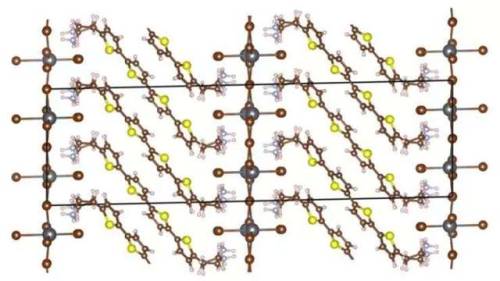#materials properties
Supercomputer predicts optical and thermal properties of complex hybrid materials
Materials scientists at Duke University computationally predicted the electrical and optical properties of semiconductors made from extended organic molecules sandwiched by inorganic structures.
These types of so-called layered “hybrid organic-inorganic perovskites"—or HOIPs—are popular targets for light-based devices such as solar cells and light-emitting diodes (LEDs). The ability to build accurate models of these materials atom-by-atom will allow researchers to explore new material designs for next-generation devices.
The results appeared online on October 4 in Physical Review Letters.
"Ideally we would like to be able to manipulate the organic and inorganic components of these types of materials independently and create semiconductors with new, predictable properties,” said David Mitzi, the Simon Family Professor of Mechanical Engineering and Materials Science at Duke. “This study shows that we are able to match and explain the experimental properties of these materials through complex supercomputer simulations, which is quite exciting.”
Post link
Engineers develop new software tool to aid material modeling research
A new software tool can accelerate materials science research by cutting out tedious background research on material properties. Penn State and Sandia National Laboratories researchers recently debuted propSym, an open-source software on the programming platform MATLAB, to calculate the fundamental constants needed to describe the physical properties of solids, such as metals, ceramics or composites.
Researchers input a material’s physical characteristics and structure, and the program produces its fundamental property constants—key values researchers need to model various materials.
“Some physical models contain hundreds or thousands of redundant components, which can make the model overwhelming,” said Anubhav Roy, a doctoral student in engineering science and mechanics in the Penn State College of Engineering and first author on the paper. “The program is able to greatly reduce the number of components for any physical property that is connected to solids with inherent crystalline symmetry.”
Post link
Macromolecular order in plastic kingdom
A team of researchers at the Institute of Synthetic Polymer Materials of the Russian Academy of Sciences, MIPT and elsewhere has determined how the regularity of polypropylene molecules and thermal treatment affect the mechanical properties of the end product. Their new insights make it possible to synthesize a material with predetermined properties such as elasticity or hardness. The paper detailing the study was published in Polymer.
In terms of production volume, polypropylene it is second only to polyethylene. By tweaking its molecular structure, polypropylene can be used to manufacture materials with a wide range of features, from elastic bands to high-impact plastic. However, the relationship between the polymer’s chemical structure and its mechanical properties is not fully understood.
What makes the properties of polymer materials so variable is their makeup. A polymer molecule is a long chain of repeating units of unequal length. If these molecules are jumbled up more or less at random in a material, it is said to be amorphous. Such polymers are soft. In other materials, the polymer chains form interconnections called crosslinks. This gives rise to regions of highly regular atomic structure (fig. 1), similar to that of crystals, hence the name crystallites. They hold the whole molecular network together, and the more crystallites there are in a material, the harder it is. To form crosslinks, molecular chains need to possess a certain structural regularity called isotacticity.
Post link



